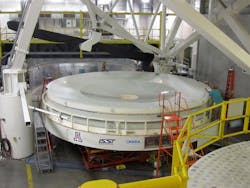LSST construction is funded; telescope contains unique primary/tertiary combo mirror developed at UA
The National Science Foundation has agreed to fund the construction of the Large Synoptic Survey Telescope (LSST) project, an observatory capable of scanning large swaths of night sky very quickly. At the heart of the telescope are mirrors developed at the University of Arizona (UA: Tucson, AZ), including a unique 8.4-m-diameter primary mirror that has an integrated 5-m-diameter tertiary mirror.
Entire sky scanned every week
The instrument will provide time-lapse digital imaging of faint astronomical objects across the entire sky (such as supernovae and asteroids), surveying the entire sky every week with its 3-billion pixel digital camera.
LSST is being carried out as an NSF and Department of Energy partnership, with NSF responsible for the telescope and site (Cerro Pachón in Chile) plus education and outreach and the data-management system, and DOE providing the camera and related instrumentation. With the approved start occurring now, LSST will see first light in 2019 and begin full science operations in 2022.
The LSST primary/tertiary design is radically different from that of other ground-based telescopes of comparable size, and increases the field of view by about a factor of ten, says Roger Angel, director of the UA's Steward Observatory Mirror Lab. The design is also compact, allowing the telescope to move quickly enough to repeatedly survey the whole sky every few nights.
"A unique aspect of this telescope is that the data will be made publicly available," says Dennis Zaritsky, deputy director of the UA's Steward Observatory and professor of astronomy in the UA Department of Astronomy. "There are many of us at the UA—especially colleagues in physics, the Lunar and Planetary Lab, and in astronomy—who are looking forward to using the data. We are in a position of competitive advantage relative to most researchers because we have access to other telescopes and planned new ones like the Giant Magellan Telescope that will enable us to follow up the most interesting discoveries from LSST with more in-depth observations."
Source: http://uanews.org/story/ua-optics-at-heart-of-telescope-poised-to-catch-the-action-in-the-universe
About the Author
John Wallace
Senior Technical Editor (1998-2022)
John Wallace was with Laser Focus World for nearly 25 years, retiring in late June 2022. He obtained a bachelor's degree in mechanical engineering and physics at Rutgers University and a master's in optical engineering at the University of Rochester. Before becoming an editor, John worked as an engineer at RCA, Exxon, Eastman Kodak, and GCA Corporation.

